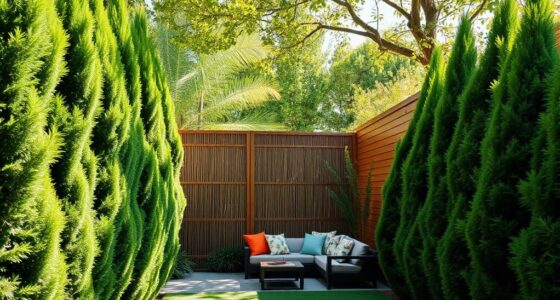Creating a beautiful yard with less work starts by choosing drought-tolerant and native plants that need less water and maintenance. Group plants with similar needs, use mulch to retain moisture, and replace traditional lawns with ground covers or gravel. Efficient irrigation and simple pruning routines keep things manageable. Incorporating these strategies boosts beauty while minimizing effort. Keep exploring to discover how designing your landscape thoughtfully can transform your outdoor space into a low-maintenance oasis.
Key Takeaways
- Use drought-tolerant native plants with deep roots to minimize watering and maintenance.
- Incorporate xeriscaping principles like grouping similar plants and reducing lawn areas with ground covers or gravel.
- Apply mulch to retain soil moisture, suppress weeds, and enhance landscape appearance.
- Design with simple plant arrangements, defined borders, and pathways to reduce upkeep and prevent plant damage.
- Choose low-maintenance plants that are pest-resistant, requiring less pruning, fertilizing, and care over time.

Creating a beautiful landscape doesn’t have to mean endless labor. If you’re looking for a way to enjoy a stunning yard without the constant upkeep, focusing on drought tolerant plants and xeriscaping principles can make a big difference. These strategies help you design a landscape that’s not only attractive but also easier to maintain, saving you time, effort, and water. By choosing plants that thrive in dry conditions, you reduce the need for frequent watering and ongoing care, which translates into a lower-maintenance yard.
Start by selecting drought tolerant plants that are naturally adapted to your climate. These plants tend to develop deep root systems, making them more resistant to drought stress and less dependent on supplemental watering. Think succulents, lavender, yarrow, and native grasses—each offers visual appeal and resilience. Incorporating these into your landscape means you’ll spend less time watering, pruning, and dealing with plant diseases or pests that often come with high-maintenance plants. Plus, native plants are often more forgiving of local weather swings, reducing the need for extra intervention. Additionally, understanding personal climate conditions can help you choose the most appropriate plants for your yard. Recognizing the contrast ratio in your landscape design can also enhance visual appeal by creating depth and focal points.
Choose drought-tolerant native plants for a low-maintenance, resilient landscape.
Applying xeriscaping principles further enhances your yard’s low-maintenance appeal. This involves designing your landscape to minimize water use and maximize efficiency. You might start by grouping plants with similar water needs together, which allows you to water more precisely and avoid waste. Replacing traditional lawns with xeriscape-friendly ground covers or gravel can cut down on mowing and edging chores. Incorporating mulches helps retain soil moisture, suppress weeds, and reduce watering frequency, while also giving your landscape a polished look. Creating defined borders and pathways not only enhances aesthetics but also directs foot traffic away from delicate plants, preventing damage and reducing the need for repair. Choosing drought tolerant plants with deep root systems can further reduce your irrigation needs over time. Moreover, selecting plants that require less fertilization contributes to a truly low-maintenance landscape. Adding timed irrigation systems can also streamline watering schedules, making maintenance even easier.
A key aspect of low-maintenance landscaping is thoughtful planning. You’ll want to consider sunlight exposure, soil type, and water availability when designing your yard. By doing so, you ensure your chosen plants will thrive with minimal intervention. Avoid overly complex plant arrangements that require frequent pruning or fertilizing. Instead, aim for a balanced, natural look that emphasizes adaptability and resilience. The contrast ratio, which affects how different elements in your landscape stand out, can be manipulated to create more vibrant visual contrasts, making your yard more attractive with less effort. Remember that efficient irrigation techniques can be integrated seamlessly into your design to further reduce water waste and maintenance. Proper soil preparation and choosing the right plant placement play significant roles in reducing ongoing care needs.
Finally, maintain your low-maintenance landscape by setting up simple routines. Regularly checking for weeds, pruning dead or overgrown parts, and mulching as needed will keep everything looking tidy without demanding too much effort. With these strategies, you’ll enjoy a beautiful yard that demands less work, more water efficiency, and a sustainable, eye-catching environment. Embracing drought tolerant plants and xeriscaping principles isn’t just good for your landscape—it’s good for your schedule and the planet. Incorporating advanced irrigation methods can further optimize water use and reduce maintenance needs.
Frequently Asked Questions
Which Plants Require the Least Watering and Fertilizing?
You should focus on plants that need minimal watering and fertilizing. By following xeriscaping principles and native plant selection, you’ll find hardy options like succulents, lavender, and yucca, which thrive with little water. These plants are adapted to your climate, reducing your maintenance efforts. Choosing native species ensures they’re well-suited to your environment, requiring less fertilization and watering, making your yard both beautiful and low-maintenance.
How Can I Prevent Weeds With Minimal Effort?
You’d think weeds would just vanish on their own, right? Actually, the best way to prevent them with minimal effort is to use effective mulching techniques. Mulching blocks sunlight and suppresses weeds naturally. Combine this with organic weed control methods—like vinegar or cornmeal—and you’ll keep your yard tidy without much fuss. It’s about working smarter, not harder, so your beautiful yard stays weed-free effortlessly.
What Are the Best Drought-Tolerant Grass Options?
When choosing drought-tolerant grasses, consider native grass varieties that thrive in your climate. These grasses often follow xeriscaping principles, requiring less water and maintenance. Options like buffalo grass, blue grama, or buffalo grass are excellent choices, providing a lush appearance with minimal effort. By selecting native species, you create a sustainable, low-maintenance lawn that resists drought and reduces your water bill.
How Often Should I Prune Low-Maintenance Plants?
Like a seasoned gardener from a bygone era, you’ll want to follow a simple pruning schedule to keep your low-maintenance plants thriving. Generally, prune once or twice a year, focusing on removing dead or damaged growth. Regular pruning promotes plant health and maintains shape, but avoid overdoing it to prevent stress. Keep an eye on your plants, and adjust the schedule if they need more or less care, ensuring your yard stays beautiful with less work.
Are There Low-Cost Materials for Sustainable Landscaping?
You can find low-cost materials for sustainable landscaping by focusing on xeriscaping principles, which emphasize water-efficient plants, and eco-friendly mulch options like shredded bark or straw. These materials help reduce water use and maintenance costs while protecting your yard. Look for local sources or reuse materials to keep expenses low. Incorporating native plants and natural mulches aligns with eco-friendly practices, making your landscape both sustainable and budget-friendly.
Conclusion
By choosing low-maintenance landscaping, you turn your yard into a stunning oasis that requires barely a fraction of the effort. With drought-tolerant plants, smart design, and minimal upkeep, you’ll spend less time working and more time enjoying your beautiful outdoor space. Imagine transforming your yard into a paradise so effortlessly perfect that it looks like a picture straight out of a magazine—without lifting a finger. Embrace easy landscaping and let your outdoor space shine with minimal work!









